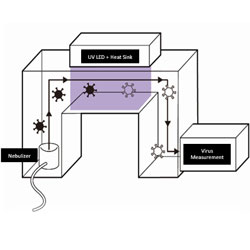
NICHIA has introduced a high radiation flux density UV-C LED. Including the Novel Coronavirus, which also inactivates and sterilizes a variety of bacteria and viruses.
3.5mm x 3.5mm LEDS, with a typical radiant flux of 62mW at a typical input power of 350mA/5.7V. The 280nm NCSU434B LED boasts the highest power conversion efficiency in the industry. And in high-density installation, the radiation flux per unit area is about 3 times that of traditional products.
By taking advantage of this flux density, manufacturers can package deep UV devices into their designs to maximize antiviral capabilities. These technical features support applications including water purification, near-surface sterilization and air purification systems to inactivate bacteria and viruses efficiently, quickly and economically.
It has been confirmed experimentally that the dose of ~1 MJ /cm2 can reduce the titer of infection to less than 1/10 (virus survival rate 4.5%) and has a positive effect on these novel coronavirus. Using their high-power 280nm leds, Nagasaki University carried out several inactivation tests on airborne droplets of a novel Coronavirus (Alpha strain and UK mutant strain), by Professor Yasuda Jiro of Hitachi Zosen and The National Research Centre for Infectious Disease Control and Prevention/Institute of Tropical Medicine.
"Since the inactivation mechanism of UV-light is based on direct denaturation of viral RNA, it is possible that the same effect could be achieved for new coronavirus mutants in addition to the current circulating UK strains such as Delta," said Professor Yasuda.